
March—April | Volume No.: 2 Issue No.: 2
Subregional Cooperation Programs in Archipelagic Southeast Asia

On the sidelines of the 20th Association of Southeast Asian Nations (ASEAN) Summit on 4 April 2012 in Phnom Penh, Cambodia, the Sixth Indonesia-Malaysia-Thailand Growth Triangle (IMT-GT1) Summit and the Eighth Brunei Darussalam-Indonesia-Malaysia-Philippines East ASEAN Growth Area (BIMP-EAGA2) Summit endorsed their respective Implementation Blueprints (IBs) for 2012–16. The IBs aim to increase project delivery through annually updated two-year rolling pipelines and strengthened institutional mechanisms. The IMT-GT supports development of five economic corridors through sector strategies in transport and energy; trade and investment; agriculture; halal products and services; tourism; and human resource development. BIMP-EAGA pursues a four-pronged strategy enhancing connectivity, establishing BIMP-EAGA as food basket for ASEAN (and the rest of Asia), promoting BIMP-EAGA as a premier regional tourism destination, and ensuring sustainable management of the environment.
ADB, through its Southeast Asia Department (SERD), has acted as Regional Development Advisor to BIMP-EAGA since 2001 and a Development Partner of IMT-GT since 2006. ADB supports these subregional groupings through regional technical assistance, providing strategic, policy and technical advice along with capacity building and institutional support, especially for regional secretariats.3
Launched in 1993 and 1994, respectively, the IMT-GT and BIMP-EAGA cooperation programs cover primarily archipelagic areas at the subnational level.4Though independent, both programs were established to help promote socioeconomic development in less developed and disadvantaged areas by increasing trade, tourism, and investment—backed by an underlying strategy of mobilizing the private sector as engine of growth. The IMT-GT is a natural geographical, historical, cultural and linguistic bloc. BIMP-EAGA is linked by a long history of trade and economic relations. The IMT-GT focuses on promoting economic and information exchange for corridor development. BIMP-EAGA has progressively worked toward greater labor mobility and trade in goods and services. Driven by the need to further integrate with the rest of Asia, both programs have been increasingly project-oriented.In2009, BIMP-EAGA and IMT-GT Leaders endorsed priority infrastructure projects to strengthen connectivity, including both “hard” and “soft” infrastructure. These are now part of the IB project pipelines. An integral part of the programs’ evolution is the process of strengthening subregional and national institutional processes and operational mechanisms.
Both IMT-GT and BIMP-EAGA subregional cooperation programs aim to converge with ASEAN’s goals, supporting the Master Plan on ASEAN Connectivity. The two subregional programs are test-beds for ASEAN agreements and key building blocks for realizing an ASEAN Community by 2015. ADB supports these subregional groupings—along with the Greater Mekong Subregion—promoting subregional-national synergies and linkages for regional cooperation and integration in Southeast Asia.
Source: ADB Southeast Asia Department.
1 The IMT-GT includes 32 provinces and states—14 provinces in southern Thailand, 8 northern states of Peninsular Malaysia, and 10 provinces covering the entire island of Sumatra in Indonesia.
2 BIMP-EAGA includes the sultanate of Brunei Darussalam; the provinces of Kalimantan, Sulawesi, Maluku, and West Papua in Indonesia; the states of Sabah and Sarawak and the federal territory of Labuan in Malaysia; and provinces in Mindanao region and Palawan in the Philippines.
3 The regional secretariats of the programs, the Center for IMT-GT Cooperation (CIMT), and the BIMP-EAGA Facilitation Center (BIMP-FC), are both based in Malaysia, with financial support from member countries.
4 With the exception of Brunei Darussalam’s national membership in BIMP-EAGA.
January—February | Volume No.2 Issue No.1
Pacific Regional Department (PARD)
ADB's Pacific Regional Department (PARD) has long been supporting RCI among its 14 Pacific developing member countries (PDMCs), often with other development partners. Contributions include support for regional development forums, infrastructure finance; regional projects focused on renewable energy, marine and coastal management; and strengthening disaster preparedness. PARD's regional technical assistance contributes to strengthening capacity for public financial management, statistics, and data collection.
Recent Developments: Supporting regional ICT connectivity
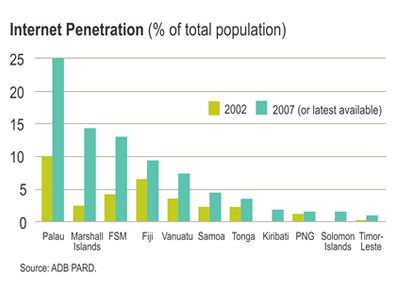
Since 2010, the Federated States of Micronesia (FSM), Papua New Guinea (PNG), Marshall Islands, Samoa, and Fiji Islands have been connected by submarine fiber-optic cables. All other PDMCs rely on satellite, which is expensive and constrained by limited bandwidth.
In response to Pacific Islands Forum leaders' call for improved international connectivity, ADB has been supporting the Pacific Regional Information and Communications Technology (ICT) Connectivity Program (initiated by the World Bank), which aims to connect Tonga, Samoa, Solomon Islands, and Vanuatu by submarine optic fiber cables to the existing global submarine cable network.
Under the first phase of the initiative, endorsed in August 2011, ADB and the WB will jointly support Tonga Cable Limited in developing a submarine cable system that includes installation of an 827-kilometer cable link between Nuku'alofa (Tonga) and Suva (Fiji). Under the second phase, (currently under preparation), support will be provided to the development of a submarine cable system for the Solomon Islands. Both projects will help improve the regulatory environment for telecommunications.
The projects are expected to improve availability and cut costs of internet services, which will open up the market for ICT-related business opportunities and boost socio-economic development through improved service delivery, notably in the health and education, among others.
October—December | Volume No.1 Issue No.5
SAARC and BIMST-EC
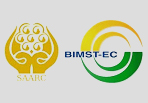
ADB supports RCI in South Asia in four ways: (i) subregionally through the South Asia Subregional Economic Cooperation (SASEC) program, (ii) regionally through the South Asia Association for Regional Cooperation (SAARC), (iii) interregionally through the Bay of Bengal Initiative for Multi-Sectoral Technical and Economic Cooperation (BIMSTEC), and (iv) through collaboration with networks of regional policy research institutes.
Recent Developments
- SASEC working groups on transport, trade facilitation, and energy convened in Bangkok, Thailand, in October 2011. They endorsed investment projects worth $2 billion, demonstrating strong SASEC commitment to strengthen transport connectivity, trade facilitation, and energy cooperation.
- ADB has assisted the SAARC Secretariat in developing detailed project proposals. These include codification of the variation in levels of capital market development, organization of regional conferences for knowledge sharing on RCI, and strengthening SAARC regional institutions. Held in Male in October 2011 with the Government of Maldives and the SAARC Secretariat. The ADB-financed SAARC Energy Trade Study (SRETS) was also adopted by SAARC Energy Ministers. STRETS is a significant step in ensuring energy security in the region.
- Under the BIMSTEC framework, ADB has prepared a technical assistance project. At the request of the BIMSTEC Working Group, the TA supports BIMSTEC's regional institutions, including its Secretariat, which was recently established in Dhaka, and expert groups in rail, road, aviation, maritime, and logistics cooperation.

(Source: GMS E-Updates, July–September 2011)
August—September | Volume No.1 Issue No.4
Greater Mekong Subregion

The Greater Mekong Subregion (GMS) comprises Cambodia, PRC (Yunnan province and Guangxi Zhuang Autonomous Region), Lao People's Democratic Republic (Lao PDR), Myanmar, Thailand, and Viet Nam. In 1992, GMS, with ADB support, launched the GMS Program of economic cooperation—now covering nine sectors: agriculture, energy, environment, human resource development, investment, telecommunications, tourism, transport, and trade. The GMS Strategic Framework, 2002–2012, envisions an integrated, prosperous, and harmonious subregion through increased connectivity, improved competitiveness, and a greater sense of community.
Recent Developments
- New GMS Strategic Framework (SF) being finalized. The new SF supports initiatives to help transform GMS transport corridors into fully fledged economic corridors within 10 years. These include multi-sector infrastructure investment linked to urban and rural development, greater focus on policies increasing infrastructure efficiency, and dealing with social and environmental concerns. GMS ministers back-ed the SF during their 17th Min-isterial Confer-ence 2–4 Aug-ust and will be formally endor-sed during the 4th GMS Lead-ers' Summit in December 2011.
- Other key ini-tiatives to be presented at the 4th GMS Summit include (i) the 2012–2016 Core Environment Program, (ii) an agreement to cooperate on accelerating construction of an Information Super-highway Network, (iii) a refocused tourism strategy, (iv) a plan for a GMS Railway Coordination Office, and (vi) a progress report on transport and trade facilitation.
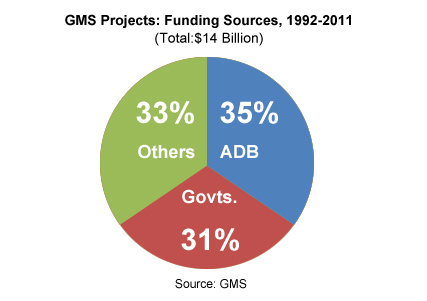
(Source: GMS E-Updates, July–September 2011)
June—July | Volume No. 1 Issue No. 3
Central Asia Regional Economic Cooperation
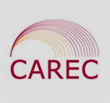
The Central Asia Regional Economic Cooperation (CAREC) Program is a partnership of 10 countries and six multilateral institutions promoting development through regional economic cooperation. CAREC proactively facilitates practical, results-based regional projects and policy initiatives in transport, energy, trade facilitation, and trade policy. ADB serves as the CAREC Secretariat, and provides financial and technical support in the implementation of priority regional projects and initiatives. CAREC is present across the region building transport and energy infrastructure, simplifying border and trade arrangements, and undertaking capacity building and knowledge sharing on priority sectors and themes through the work of the CAREC Institute.
Recent Developments
- 2011 marks CAREC's 10 years of institutional cooperation. Activities include (i) a 10-year strategic framework (CAREC 2020) and a 10-year study on CAREC achievements; (ii) convening of a development partner's forum; and (iii) production of a commemorative video on CAREC achievements.
- Almost $10 billion has been committed through ADB's multi-tranche financing facility (MFF) mechanism in the CAREC transport and energy sectors. To date, nearly $3 billion has been implemented through approval of 16 tranches of the CAREC MFFs.
- Recent ADB CAREC investments include (i) the Hairatan to Mazar-e-Sharif Railway in Afghanistan; (ii) the Western PRC to Western Europe International Transit Corridor in Kazakhstan; (iii) the Bishkek-Torugart Road in Kyrgyz Republic; (iv) Regional Road Investment Program in Uzbekistan; (v) the North-South Railway Project in Turkmenistan; and (vi) the Talimarjan power project in Uzbekistan—Central Asia's first 800-megawatt combined-cycle gas turbine power plant.
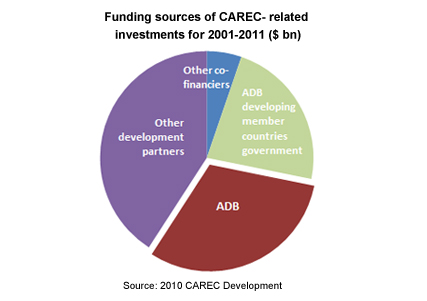
(Source: CAREC Institute.)
